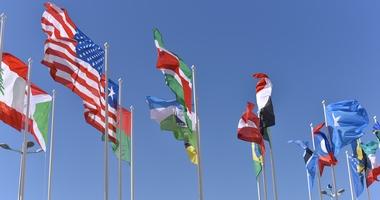
Workers Rights and the Climate Crisis
While all outdoor workers will be affected by rising temperatures, the impacts will be unequally distributed across sectors and regions, further exacerbating climate injustice.
We are all familiar with those summer days – the ones that result in sweaty brows and pit stains the moment you step outside. While some may be able to seek refuge in air-conditioned buildings, farm workers, construction workers, mail carriers, sanitation workers, and other outdoor workers don’t have the same luxury.
Between 1992 and 2017, in the US alone, heat stress killed 815 workers and seriously injured over 70,000 more - with even more incidences going unreported. Thanks to climate change, these types of days are becoming more frequent and more deadly.
Warming World: A Double Whammy
One indicator of heat stress is the wet-bulb temperature (WBT), which combines temperature and humidity. Heat-related illnesses and deaths occur when the body cannot properly cool itself down, which humans typically do by sweating. If temperatures are high and humidity is high, sweat does not evaporate as quickly because of excess moisture in the air.
Real-world data suggests that the maximum WBT humans can handle is somewhere around 31°C WBT at 100% humidity, though WBTs lower than that have created deadly events, like the two heat waves in India and Pakistan in 2015 that killed around 4,000 people at 30 WBT. Likewise, the heat wave in the Pacific Northwest US in 2021 that killed at least 200 people registered a WBT of 25C.
A warming world is creating a lethal mix: as temperatures rise, warmer air holds onto more moisture, causing humidity to rise and leading to a higher WBTs.
Work, Heat Stress, and Climate Justice
While all outdoor workers will be affected by rising temperatures, the impacts will be unequally distributed across sectors and regions, further exacerbating climate injustice.
By 2030, heat stress is poised to wipe out 80 million full-time jobs worth of productivity. And if we want to talk money, that’s a loss of $2.4 trillion - undoubtedly a blow to the global economy.
Importantly, it could also plunge millions of workers who are already living on less than $1.90 a day deeper into working poverty.
Agricultural workers and construction workers will account for 60% and 19%, respectively, of lost work hours. Due to a combination of susceptibility to extreme temperatures and a high share of employment in agriculture, subregions like Southern Asia and Western Africa will be the worst affected by these losses.
And we’re already seeing this play out in real life. A heat wave in India earlier this year decimated the nation’s expected wheat harvest, prompting a ban on wheat exports. If it’s not the heat that kills them, it’s the stress of mounting debt due to crop failure and lack of government protections – as one study suggests, suicides of over 59,000 Indian farmers were linked to rising temperatures.
Relative to lower-middle and low-income regions, high-income regions will be affected to a far lesser extent. But when harm is done, the most vulnerable workers in the region will feel the most impact.
For instance, 73% of farmworkers in the US are immigrants and about half of them are undocumented. Heat stress adds another layer of detriment to workers who do not have adequate access to health care and are already more vulnerable to wage theft and other labor abuses due to their immigration status. With the number of days farmworkers will be working in unsafe temperatures expected to nearly triple by 2100, these compounding vulnerabilities mean immigrant workers will face immense pressure to continue working in lethal heat.
These projections, slowly becoming reality, just confirm what we already know: the countries and people who have contributed the least to the climate crisis will be the most impacted.
There’s No Escaping
Outdoor workers with direct exposure to the elements will certainly be impacted, but heat stress can also penetrate the four walls of any building and strike those working indoors too.
Just this summer, a worker died in an Amazon warehouse in New Jersey likely due to heat stress, resulting from a lack of air circulation and cooling. These unsafe indoor working conditions will only be intensified by more frequent power outages affecting outdated electric grids.
Even if you aren’t working, heat stress on workers will ultimately affect you. Let’s bring it back to farmworkers. Sweltering working conditions with no protections will sicken or kill workers and drive them away from a sector already experiencing a labor shortage, threatening food supplies and making your grocery trip a lot pricier.
There are also the people repairing our bridges, delivering our life-saving medications, collecting our trash, fighting our fires, and the hundreds of other things that workers impacted by heat stress do to make sure everything is running smoothly.
Here’s the Part Where We Do Something About It
We know the situation sounds pretty dire right now, but like many climate-change-related issues, it’s not too late to do something about it.
Occupational safety policies related to heat stress must be passed. In the US, the Occupational Safety and Health Administration (OSHA) is in the early stages of developing a federal heat standard, but it could take years before it is implemented. Meanwhile, five states have successfully passed regulations to require employers to provide shade, water, heat stress training, and adequate breaks when certain temperatures are reached, and others are in the process of doing so.
But there’s a lot more we could be doing. Across the Middle East, midday work bans have been established during the summer months, with hefty penalties for violating the ban. Germany set indoor temperature limits, with additional protection measures, including adequate indoor ventilation, relaxed clothing regulations, and reduction in work hours.
Unions are paramount to fostering workspaces where workers are empowered to speak up about heat stress and demand change without fear of retaliation. For instance, after a telecommunications worker died from heat exposure on the job in 2011, the Communications Workers of America union became the first union to have negotiated protections from heat stress.
Additionally, an international labor standard for heat stress, along with guidelines developed for local environments and the strengthening of social safety nets for workers, would be incredibly impactful.
To ensure safety for workers in the long-term, we need to get to the root of the problem: climate change. Rising temperatures are just one of many adverse effects of the climate crisis impacting workers. And we haven’t even touched on more frequent and harsher weather disasters.
We need to fend off this existential crisis for the sake of the workers who keep our society from falling apart. You can be part of the solution by fighting for local change in our US-based chapters or training to join our global community of Climate Reality Leaders.
Stay up to date with the latest climate news and ways to get involved in the movement for solutions by signing up for our email list:




